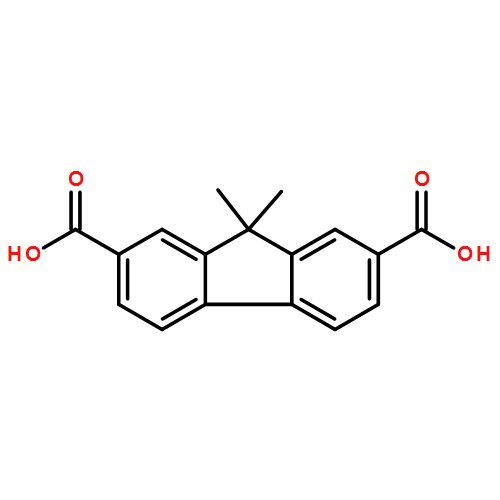Co-reporter: Xinhui Zhou, Honghui Li, Hongping Xiao, Liang Li, Qiang Zhao, Tao Yang, Jinglin Zuo and Wei Huang
pp: 5718-5723
Publication Date(Web):04 Feb 2013
DOI: 10.1039/C3DT00055A
A microporous metal–organic framework (MOF) Eu3(MFDA)4(NO3)(DMF)3 (1, H2MFDA = 9,9-dimethylfluorene-2,7-dicarboxylic acid) has been solvothermally synthesized and structurally characterized by single-crystal X-ray diffraction. 1 is a three-dimensional coordination polymer with pcu type rod-packing structure, through which 1D rhombic channels penetrate. The solvent-free form 1a could be obtained by direct heating of 1. Both 1 and 1a exhibit high intensity red light emissions with high quantum yields and long luminescence lifetimes when excited at 336 nm at ambient temperature. The potential of 1a for nitro explosive sensing is studied through luminescence quenching experiments, which show that 1a is a potential luminescent sensory material for nitro explosives.
Co-reporter: Xinhui Zhou, Honghui Li, Hongping Xiao, Liang Li, Qiang Zhao, Tao Yang, Jinglin Zuo and Wei Huang
pp: NaN5723-5723
Publication Date(Web):2013/02/04
DOI: 10.1039/C3DT00055A
A microporous metal–organic framework (MOF) Eu3(MFDA)4(NO3)(DMF)3 (1, H2MFDA = 9,9-dimethylfluorene-2,7-dicarboxylic acid) has been solvothermally synthesized and structurally characterized by single-crystal X-ray diffraction. 1 is a three-dimensional coordination polymer with pcu type rod-packing structure, through which 1D rhombic channels penetrate. The solvent-free form 1a could be obtained by direct heating of 1. Both 1 and 1a exhibit high intensity red light emissions with high quantum yields and long luminescence lifetimes when excited at 336 nm at ambient temperature. The potential of 1a for nitro explosive sensing is studied through luminescence quenching experiments, which show that 1a is a potential luminescent sensory material for nitro explosives.
Co-reporter: Xin-Hui Zhou, Liang Li, Hong-Hui Li, Ao Li, Tao Yang and Wei Huang
pp: 12403-12409
Publication Date(Web):18 Jun 2013
DOI: 10.1039/C3DT51081F
A metal–organic framework (MOF) {[Eu2(MFDA)2(HCOO)2(H2O)6]·H2O}n (1) (H2MFDA = 9,9-dimethylfluorene-2,7-dicarboxylic acid) has been solvothermally synthesized and structurally characterized. 1 possesses the three-dimensional pcu type rod-packing structure with one-dimensional rhombic channels. The framework of 1 can reversibly shrink/swell along the c axis upon partial/full release of the water molecules. Correspondingly, the rhombic channels become narrow/large and 1 transforms to narrow-pore 1a/large-pore 1b. 1, 1a and 1b have almost the same excitation and emission spectra with the strong characteristic red-light-emission of Eu(III). A high photoluminescence quantum yield of 77% and long luminescence lifetime of around 1.1 ms was observed for 1. The potential of 1b for Fe3+ ions and PA sensing was studied in DMF through the luminescence quenching experiments, which show 1b is a potential turn-off luminescent sensory material for the selective detection of Fe3+ ions and PA with detection limits of around 10−7 M for both of them. The fluorescence quenching mechanism for Fe3+ ions and PA was also investigated.
Co-reporter: Xin-Hui Zhou, Liang Li, Hong-Hui Li, Ao Li, Tao Yang and Wei Huang
pp: NaN12409-12409
Publication Date(Web):2013/06/18
DOI: 10.1039/C3DT51081F
A metal–organic framework (MOF) {[Eu2(MFDA)2(HCOO)2(H2O)6]·H2O}n (1) (H2MFDA = 9,9-dimethylfluorene-2,7-dicarboxylic acid) has been solvothermally synthesized and structurally characterized. 1 possesses the three-dimensional pcu type rod-packing structure with one-dimensional rhombic channels. The framework of 1 can reversibly shrink/swell along the c axis upon partial/full release of the water molecules. Correspondingly, the rhombic channels become narrow/large and 1 transforms to narrow-pore 1a/large-pore 1b. 1, 1a and 1b have almost the same excitation and emission spectra with the strong characteristic red-light-emission of Eu(III). A high photoluminescence quantum yield of 77% and long luminescence lifetime of around 1.1 ms was observed for 1. The potential of 1b for Fe3+ ions and PA sensing was studied in DMF through the luminescence quenching experiments, which show 1b is a potential turn-off luminescent sensory material for the selective detection of Fe3+ ions and PA with detection limits of around 10−7 M for both of them. The fluorescence quenching mechanism for Fe3+ ions and PA was also investigated.


